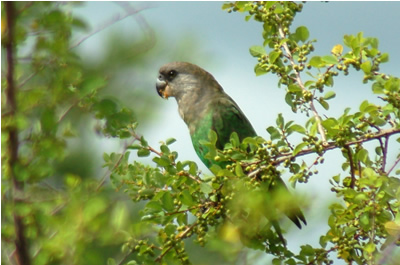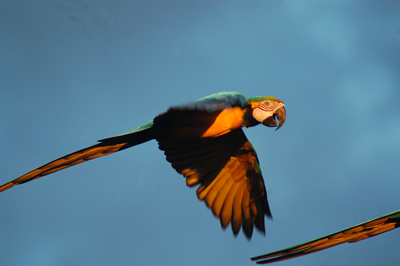Parrot News
8 September 2009
Contrasting phylogeographic patterns in mitochondrial Dna and microsatellites: evidence of female philopatry and Male-biased gene flow among regional populations of the Blue-and-yellow macaw (psittaciformes: Ara ararauna) in Brazil
In: The Auk 126(2):359-370, 2009
by: Renato Caparroz, Cristina Y. Miyaki, and Allan J. Baker
Abstract: Comparing the patterns of population differentiation among genetic markers with different modes of inheritance can provide insights into patterns of sex-biased dispersal and gene flow. The Blue-and-yellow Macaw (Ara ararauna) is a Neotropical parrot with a broad geographic distribution in South America. However, little is known about the natural history and current status of remaining wild populations, including levels of genetic variability. The progressive decline and possible fragmentation of populations may endanger this species in the near future. We analyzed mitochondrial DNA (mtDNA) control-region sequences and six microsatellite loci of Blue-and-yellow Macaws sampled throughout their geographic range in Brazil to describe population genetic structure, to make inferences about historical demography and dispersal behavior, and to provide insight for conservation efforts. Analyses of population genetic structure based on mtDNA showed evidence of two major populations in western and eastern Brazil that share a few low frequency haplotypes. This phylogeographic pattern seems to have originated by the historical isolation of Blue-and-yellow Macaw populations 374 000 years ago and has been maintained by restricted gene flow and female philopatry. By contrast, variation in biparentally inherited microsatellites was not structured geographically. Male-biased dispersal and female philopatry best explain the different patterns observed in these two markers. Because females disperse less than males, the two regional populations with well-differentiated mtDNA haplogroups should be considered two different management units for conservation purposes.
7 September 2009
Vocal matching by Orange-fronted conures (Aratinga canicularis)
In: Behavioural Process. 2009
by: Thorsten Balsby and Jack Bradbury
Abstract: The functions of vocal matching have been clarified in territorial songbirds, compositionally stable groups of birds and mammals, and species with multiple alarm or assembly signals. The functions of vocal matching are less well understood in fission/fusion species that are non-territorial, live in groups with variable composition, and lack multiple alarm signals. The authors present the results of interactive playbacks in a fission/fusion parrot species, the orange-fronted conjure (Aratinga canicularis), that provide evidence of vocal matching. A randomly selected loud contact call (chee) per trial was played to passing wild flocks and short-term captives in Costa Rica. Of the trials where subjects interacted, 30% of wild flocks and 21% of captive trials showed significantly linear or curvilinear changes in similarity between the stimulus and response chees over the course of the trial. Surprisingly, both convergent and divergent sequences were observed, and many trials lacking a single trend showed disjunct changes in stimulus–response similarity. These results suggest that chee exchanges prior to flock fusions are not simply an exchange of greetings but are more likely some form of negotiation. This would explain the presence of convergent, divergent, and variable patterns of stimulus–response similarity seen in these experiments.

White-eyed parakeet (Aratinga leucophthalma) flock, southeastern
Peru. A.Lee
4 September 2009
Generalists, specialists and opportunists: niche metrics of Poicephalus parrots in southern Africa
Ostrich 80(2):93-97. 2009
by: Rutledge Boyes and Michael Perrin
Abstract: There are distinct differences in the way in which Poicephalus parrots utilise food resources within their distributional range. Our study evaluated the niche metrics of all Poicephalus parrots studied thus far for evidence of linkages between body mass, distributional range and niche breadth. We calibrated the degree of dietary specialisation of Meyer's Parrots in the Okavango Delta, Botswana, over 12 months using a modified Hurlbert's expanded and standardised niche breadth index, and for comparison using Levins's niche breadth, with the food item calendars of the other Poicephalus parrots in southern Africa. Our study showed that Meyer's Parrot has the widest niche breadth of any Poicephalus parrot studied thus far, which likely plays a role in their wide distributional range. In addition, degree of dietary specialisation was inversely correlated with body mass, whereby the narrower the trophic niche, the larger the body size.

Brown-headed parrot (Poicephalus cryptoxanthus)
Kruger National Park, South Africa. A.Lee
3 September 2009
Factors influencing nest spacing of a secondary cavity-nesting Parrot: Habitat heterogeneity and proximity of conspecifics
The Condor 111(2):305-313. 2009
by: Alejandro Salinas-Melgoza, Vicente Salinas-Melgoza and Katherine Renton
Abstract: Resource availability in a heterogeneous environment and density-dependent processes may influence the spatial distribution of individuals among habitats. The distribution of nests of secondary cavity nesters is rarely clumped because the birds are constrained by the distribution of existing cavities as nest resources. In this study, to evaluate the interplay of environmental and behavioral processes in the spacing of parrot nests, we compared the spatial distribution of active Lilac-crowned Parrot (Amazona finschi) nests with that of all cavities used as nests over 14 years. Parrots reused 42% of cavities, and the frequency of reuse was significantly associated with a previously successful nesting attempt. Positive fitness benefits of cavity reuse may indicate high-quality nest sites that are used more intensively by resident breeding pairs. Spatial-point-pattern analysis indicated that trees used as nests were significantly clustered within 60 m in the three nesting areas, with average distance of 100–200 m between nest trees. In a given breeding season, active parrot nests were separated by a mean 950 ± 890 m. Parrot nests were also located significantly closer to a tree used as a nest in the previous breeding season than the distance between nearest nesting conspecifics. This pattern suggests that conspecifics influence the spatial distribution of reproductive pairs breeding simultaneously, with nesting pairs occupying areas where suitable cavities are more numerous. The behavioral spacing requirements of nesting parrots may limit breeding densities and restrict management strategies to increase numbers of nesting pairs within protected areas.
